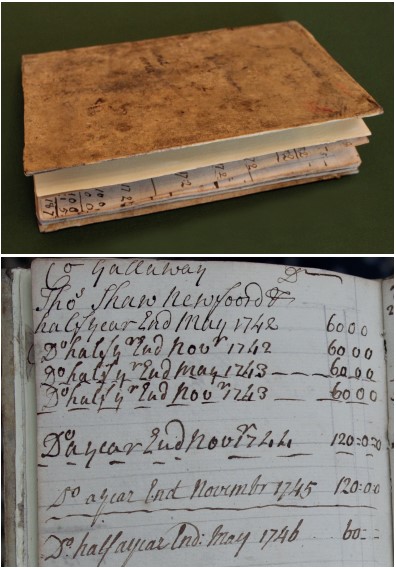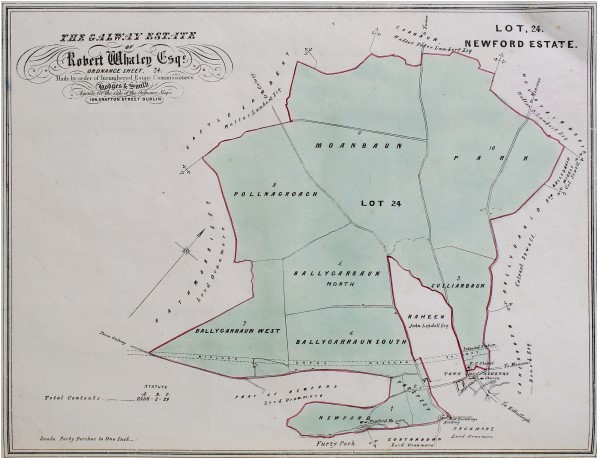A mid-eighteenth-century mystery rent-book
Published in Issue 5 (September/October 2021), Volume 29By Patria McWalter

Top: The pocket-sized notebook, measuring 17cm x 13cm and bound with a crude parchment cover, has good-quality rag paper. (Above ) One of the entries for ‘Co. Gallaway’—‘Thos Shaw, Newford/Half year end May 1742 [£]60.0.0’.
The notebook contains what appear to be debit and credit entries, dating from 1742–68, primarily relating to property in ‘Co. Gallaway’ but also to Crane Lane in Dublin and various lands in County Louth. It includes tenants’ names and details of the amount due for a specific period, such as ‘Thos Shaw Newford half year end May 1742 [£]60.0.0’. The details are then repeated for subsequent periods. The entries on the credit side often provide a little more detail, such as ‘Paid to Richard Dawson [£]60.0.0’. (Dawson may have been an agent.)
While the tenant’s name is given, there is just an odd reference to the name of the rented property or land, and no mention of the name of the owner or landlord of the property. George Peacock, Charles Eccles, John Fitzgerald, Robert Armstrong, David Power, Eyre French, Thomas Shekelton, Alderman Armitage (Louth) and Coole are some of the names found throughout the volume. There are also references to Newry and Dundalk.
With limited information available, the hunt to establish the provenance began with an initial search of the Landed Estates Database (hereafter referred to as the LED). This is an absolute gem of a resource, developed by the Moore Institute at NUI, Galway. It provides background details of landed estates in Connaught and Munster, and, more importantly, the location of related surviving archival material and secondary source material.
As the entry in the notebook for Shaw includes the word ‘Newford’, a search was carried out for both Shaw and Newford. The LED Shaw entry indicates that the family ‘held land and premises in the towns of Athenry and Galway in the early eighteenth century. Their residence appears to have been at Newford, in the parish and barony of Athenry.’ The entry for Newford indicates that in ‘1786, Wilson mentions Newford as the seat of Edward Browne. In 1814 Thomas Tighe is recorded as residing at Newford. … The house was later part of the Whaley and Perry estates in the 1850s and was offered for sale in the Encumbered Estates court in 1852.’
Meanwhile, a query was issued to Louth County Archives, to establish whether they might have any knowledge of or material relating to some of the individuals listed under County Louth in the volume, such as Caragher and Armitage at Drummin. Reaching out to Louth County Archives was thought to be a long shot, but within an hour the ever-helpful and resourceful archivist, Lorraine Buchanan, sent an article from the County Louth Archaeological and History Society Journal which appeared to solve the mystery. The article, ‘Caher of Cardistown Family Papers’ by Diarmuid Mac Iomhair, establishes links through land and intermarriage between the Carahers of Coole, the Armitages and the Whaleys from the early 1700s onwards.
It indicates, for instance, that Timothy Armitage and Priscilla Parkinson, who married between 1690 and 1697, had three daughters, one of whom married Richard Chappell Whaley, MP for Wicklow—‘The Whaleys had John, who in turn had Robert … whose property of 9,000 acres was sold in 1852 for £38,080’. This relates to a sale of the lands in the Encumbered Estates Court in 1852, which was also referenced in the LED entry.
The next step was to review the related printed ‘Rental’, a copy of which is held in the Local Studies section of Galway Public Libraries at Island House, Galway. It indicates that Newford was part of the Whaley estate in the 1850s and sold in the Encumbered Estates Court in 1852. A review of the rental reveals that Robert Whaley also owned land in counties Armagh, Carlow and Louth, so all the pieces of the jigsaw appeared to fit together. Indeed, the rental indicates that in February 1788 John Whaley leased the lands of Coole to Michael Caraher. It also states that ‘Mr Caraher is a gentleman of considerable landed property and in every way a desirable and improving tenant’.

Above: Map of the Whaley estate at Newford, Co. Galway, near Athenry, one of several holdings spread across the country. (All images: Galway County Council Archives)
The LED entry on Whaley indicates that ‘John Whaley was granted over 1,600 acres in the county of the town of Galway with additional lands in the baronies of Leitrim, Loughrea, Athenry and Moycullen by patents dated 23 Oct 1667, 6 May 1669 and 3 Aug 1678. Richard Whaley of Newford, Member of Parliament for Athenry, died in 1725. His son Richard Chappell Whaley lived at Whaley Abbey, county Wicklow.’
So from all this research, and in particular with the assistance of Lorraine at Louth County Archives, with the names of the tenants and the very odd reference to a property location, there is sufficient evidence to indicate that the notebook came from the Whaley estate, and more specifically from Richard Chappell Whaley. This small item (GS19/05) from the mid-1700s, with beautiful penmanship, provides some wonderful evidence relating to the estate’s landholdings, spread across the country, and how it administered its finances. It’s a little archival treasure, worthy of further investigation!
Patria McWalter is Galway County Council Archivist.
















